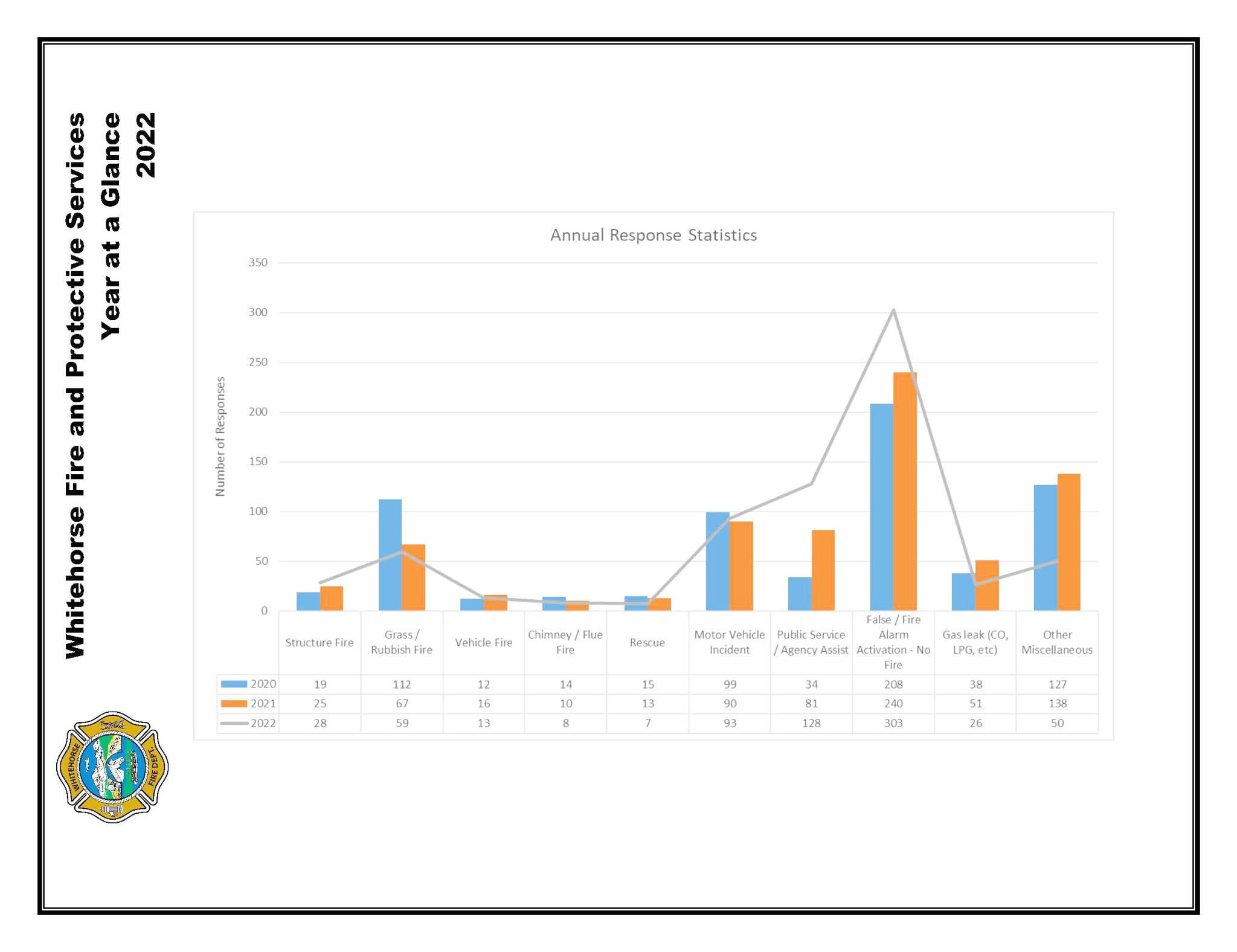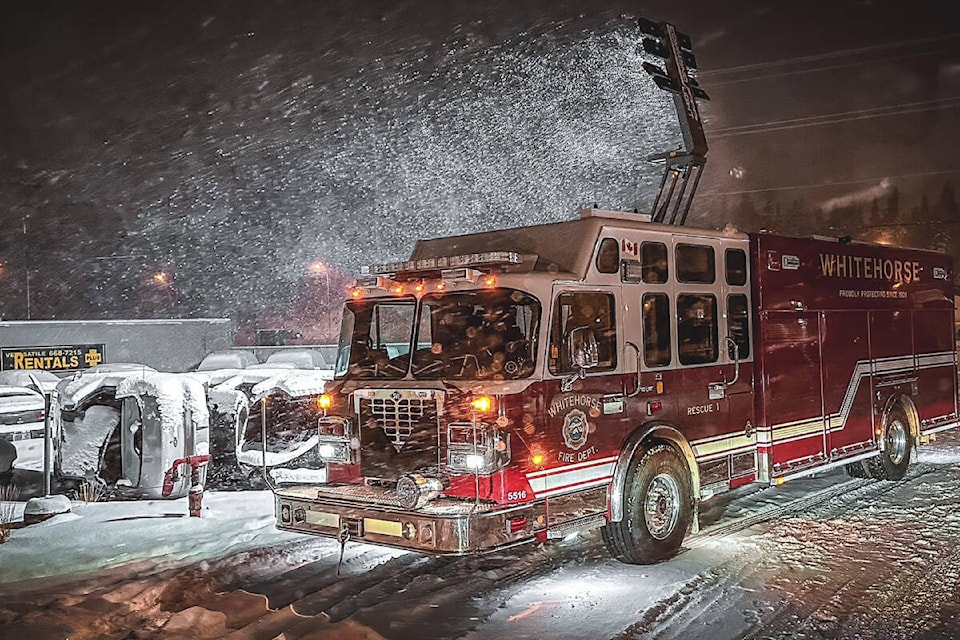Whitehorse firefighters received slightly fewer calls for service overall last year, though the number of calls coming in for false alarms and to assist other agencies rose significantly.
Whitehorse Fire and Protective Services has released its data detailing 2022 calls.
“We see our general call volume remaining constant (within +/- 5%), although a shift towards more false fire alarms and agency assist calls have occurred,” the fire department noted in a social media post highlighting the numbers.
Whitehorse fire chief Jason Everitt said the figures, along with those from years past, will be used as the department moves forward with more long-term planning.
“Data drives decisions,” he said in a Jan. 6 interview, adding the fire department has greatly benefitted from the assistance of a member who has collected and catagorized the information in recent years.
The department is looking at getting software that will allow it to delve deeper into the details, such as what areas of town calls came in from over the course of the year and time frames.
It will be information “which really tells a story,” Everitt said, noting it could have a significant impact on strategic planning for the department years into the future.
While the department plans ahead for the future, Everitt is getting set to leave the territory as his contract with the city comes to an end. Everitt will be moving to Saskatchewan to take a job at the 15 Wing Canadian Forces Base in Moose Jaw.
Whitehorse’s deputy fire chief Jason Wolsky will serve as acting fire chief until a new chief is hired. A recruitment firm has been retained for that search, city officials said in an emailed statement.
Looking back on 2022, the data show a total of 715 calls came into the department in 2022, down two per cent from 2021 when there were 731 calls. In 2020, a total of 678 calls came in. Significant COVID-19 restrictions were in place that kept many people home for lengthy periods in 2020.
As for the types of calls, the public service/agency assist category saw the largest increase of 58 per cent with 128 calls compared to 81 in 2021 and 34 in 2020.
Everitt said the city’s department assists the airport fire department, the territory’s Wildland Fire Management branch and other nearby volunteer fire departments through mutual aid agreements, as well as the RCMP and ambulance services.
As Everitt noted, it’s incumbent upon emergency responders to ask for help when needed and for the Whitehorse fire department this can take the form of providing fire fighting resources or having the department fill in the gaps as needed. Similarly, the department benefits from the assistance of other agencies when needed.
Everitt said the opioid crisis has had an impact as firefighters have had to respond to calls for emergency medical services (EMS) when EMS is already tied up, providing care until EMS can get to the situation.
It also means helping RCMP or EMS access a building as the department has the tools and training to get into locked buildings without breaking down a door.

The false/fire alarm activation where there’s been no fire saw a 26 per cent increase from 240 in 2021 to 303 in 2022. There were 208 such calls in 2020.
The increase is, in part, due to more alarms being installed in buildings, Everitt said, stressing the importance of security firms being informed of when an alarm is being tested as that can result in unnecessary calls to the fire department about the alarm if the plans for maintenance aren’t made clear. It means that firefighters are responding to the calls as bona fide events, meaning resources that would otherwise be available are not.
“There is a risk,” Everitt said, noting the department works to determine why each alarm goes off and, in cases of false alarms, will put in efforts to provide education.
Under the City of Whitehorse fees and charges bylaw, fines of up to $200 can be levied if there are two false alarms in a 12 month period due to vandalism, defective systems or negligence of the building owner, tenant or contractor.
The 2022 data on fire department responses also show smaller increases in structure fires and motor vehicle incidents.
A 12 per cent increase compared to 2021 was noted for structure fires with 28 structure fires in 2022 and 25 in 2021. A total of 19 were noted in 2020.
Meanwhile, motor vehicle incidents were up three per cent from 2021 when there were 90. In 2022, there were 93, while 2020 saw 99.
On the downward trend were all other categories listed.
The other/miscellaneous category, including everything not otherwise covered, saw the largest decrease of 64 per cent, with 50 calls in 2022 compared to 138 in 2021. A total of 127 calls in that category were recorded in 2020. Everett said the significant decrease likely came due to changes in some of the categories covered.
Everitt described the other/miscellaneous category as those that don’t fit into the standard types of calls that come in. It may be someone has a concern about whether their smoke alarm is working properly or could be a strange smell someone notices in the area and calls the department about.
Gas leaks also appear to be on the decline with a 49 per cent decrease in calls in 2022 when 26 calls came in compared to 51 in 2021. In 2020, the department responded to 38 calls about gas leaks.
The number of rescues the department responded to was also down significantly at 46 per cent compared to 2021 when 13 calls came in. The figures show a steady decline in rescue calls with 15 noted in 2020 and just seven in 2022.
Also continuing with a downward trend are chimney/flue fires with 14 recorded in 2020, 10 in 2021 and eight in 2022, representing a 20 per cent decrease over the last two years; and grass/rubbish fires with 112 in 2020, 67 in 2021 and 59 in 2022, representing a 12 per cent decrease over the last two years.
Rounding out the figures are vehicle fires, which saw a 19 per cent decrease from 16 in 2021 to 13 in 2022. There were a total of 12 in 2020.
As Everitt gets set to leave the territory, the city is praising the work he’s put in since he arrived in 2020.
“We want to thank Chief Everitt for his commitment to the community,” the city said. “He has had an incredible impact on the members of the Whitehorse Fire Department.”
Contact Stephanie Waddell at stephanie.waddell@yukon-news.com
